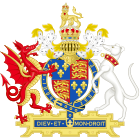Suppression of Religious Houses Act 1539 facts for kids
| Act of Parliament | |

|
|
| Long title | An Acte for dissolucion of the Abbeys. |
|---|---|
| Citation | 31 Hen. 8. c. 13 |
| Other legislation | |
| Repealed by |
|
|
Status: Repealed
|
|
The Suppression of Religious Houses Act 1539 was an important law made by the Parliament of England. It is also known as the Second Act of Dissolution or the Act for the Dissolution of the Greater Monasteries. This law was a big part of a time called the Dissolution of the Monasteries in England.
Contents
What Was the 1539 Act?
This law was passed in 1539. Its main goal was to close down many religious places. These places were called monasteries, abbeys, and convents. The Act allowed the King to take control of their land and wealth.
Why Did It Happen?
The Act was part of a major change in England. This change was led by King Henry VIII. He wanted to divorce his first wife, Catherine of Aragon. The Pope, who was the leader of the Catholic Church, would not allow it. So, Henry VIII decided to break away from the Pope's authority. He made himself the head of the Church of England. This event is known as the English Reformation.
To show his power and gain wealth, King Henry VIII started to close down monasteries. He had already passed a law in 1535. That law, the Suppression of Religious Houses Act 1535, closed smaller monasteries. The 1539 Act finished the job by closing the larger ones.
What Were Monasteries?
Monasteries were communities where monks or nuns lived. They dedicated their lives to religion. These places were very important in England for hundreds of years. They were not just religious centers. They also acted like hospitals, schools, and inns for travelers. Monasteries often owned a lot of land and were very wealthy. They provided charity to the poor and helped local communities.
What Did the Act Do?
The 1539 Act specifically targeted the remaining 552 monasteries. These were the larger and often richer ones. The Act gave all their property, including land, buildings, and money, to the King. This greatly increased the King's wealth. It also gave him more power over the country.
The monks and nuns living in these places were forced to leave. Some were given small pensions. Many lost their homes and way of life. The buildings themselves were often torn down. Their materials were sometimes used for other projects. The land was sold off to wealthy nobles and merchants. This created a new group of powerful landowners who supported the King.
What Happened Next?
The Dissolution of the Monasteries had a huge impact on England. It changed the landscape, the economy, and the social structure. Many historical buildings were lost forever. The system of charity provided by the monasteries also ended.
Over time, the Suppression of Religious Houses Act 1539 was removed from law. This happened much later, in the 20th century. Parts of the Act were officially repealed by the Statute Law (Repeals) Act 1969 and the Statute Law (Repeals) Act 1989. This means the law is no longer in effect today.
See also

